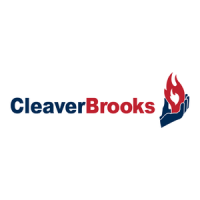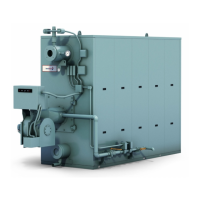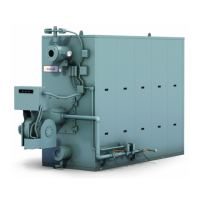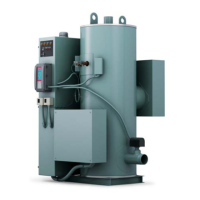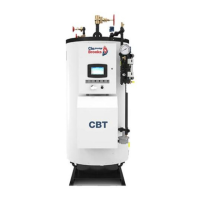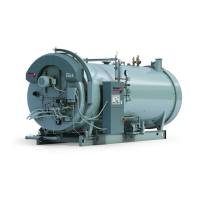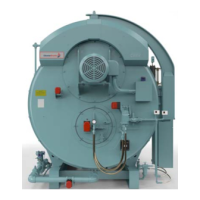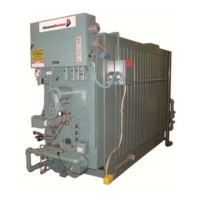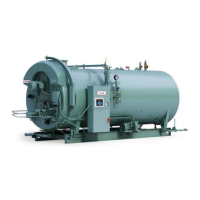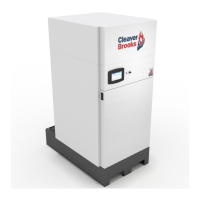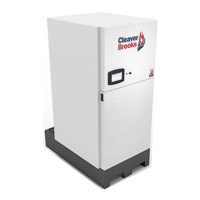Chapter 5 Adjustment Procedures
5-8 750-177
maximum CO level standardly allowed is less than 400 ppm.
However, this may change subject to local regulations.
The percent O
2
recorded on an instrument equates to percent
excess air, I.E. 3% O
2
is approximately 15% excess air and
4% O
2
is approximately 20% excess air. The exact percentage
of excess air is a mathematical calculation based on an
ultimate fuel analysis of the fuel being fired.
It is generally recommended that O
2
readings of between 3%
to 5% be attained with less than 400 ppm CO, at high fire.
Using information from Section O of Chapter 6, determine
the standard conditions of gas pressure and flow for the size
boiler and the gas train on it. Calculate the actual pressure and
flow through the use of correction factors that compensate for
incoming gas pressure and altitude.
Basically, gas adjustments are made with a gas pressure
regulator, which controls the pressure and with the butterfly
gas valve which directly controls the rate of flow.
The low fire setting should be regarded as tentative until the
proper gas pressure for high fire operation is established.
To reach the high fire rate, turn the manual flame control
switch toward “OPEN” in minor increments while
monitoring combustion for overly rich or lean conditions.
At high fire, the gas butterfly valve should be open as wide as
indicated by the slot on the end of the shaft.
Determine the actual gas flow from a meter reading. (See
Section O of Chapter 6.) With the butterfly valve open and
with regulated gas pressure set at the calculated pressure, the
actual flow rate should be close to the required input. If
corrections are necessary, increase or decrease the gas
pressure by adjusting the gas pressure regulator, following
the manufacturer's directions for regulator adjustment.
When proper gas flow is obtained, take a flue gas reading.
The O
2
should be between 3% and 5% at high fire.
If the fuel input is correct, but the O
2
values do not fall within
this range, the air damper settings may need to be adjusted.
Adjustment of the air damper linkage is described in Section
B of Chapter 6.
With the high-fire air/fuel ratio established, the gas pressure
regulator needs no further adjusting.
After being certain that the air control damper and its linkage
are correctly adjusted to provide the proper amount of
secondary air, and after adjusting the gas pressure regulator,
final adjustment can be made, if necessary obtain a constant
air/fuel ratio throughout the entire firing range.
Input of combustion air is ordinarily fixed at any given point
in the modulating cycle, the flue gas reading is determined by
varying the input of gas fuel at that setting. Standard Burner
Low Fire Adjustment
The fuel input should be adjusted using the linkage to
approximately 33% of that at high fire. At low fire the O
2
flue
gas reading should be between 3-5%.
If the air damper needs to be adjusted in order to provide the
correct low fire air/fuel ratio, combustion must be rechecked
at higher firing rates and adjusted as required.
Q. LOW GAS PRESSURE SWITCH
Adjust the scale setting to slightly below the normal burning
pressure. The control circuit will be broken when pressure
falls below this point. Since gas line distribution pressure
may decrease under some conditions, shutdowns may result
if the setting is too close to normal. However, regulations
require that the setting may not be less than 50% of the rated
pressure downstream of the regulator.
Manual resetting is necessary after a pressure drop. Press the
reset lever after pressure is restored. Be sure that the mercury
switch equipped control is level.
R. HIGH GAS PRESSURE SWITCH
Adjust the scale setting to slightly above the normal burning
pressure. The control circuit will be broken when pressure
exceeds the normal operating pressure. Unnecessary
shutdowns may result if the setting is too close to normal;
however, regulations require that the setting may not be
greater than 150% of rated pressure.
Manual resetting is necessary after a pressure rise. Press the
reset lever after pressure falls. Be sure that the mercury
switch equipped control is level.
S. FUEL OIL PRESSURE AND
TEMPERATURE - GENERAL
Variations in burning characteristics of the fuel oil may
occasionally require adjustments to assure highest
combustion efficiency. The handling and burning
characteristics may vary from one delivery of oil to another.
Therefore, it is recommended that the oil system be inspected
from time to time to verify that pressures and viscosity are at
the proper operating levels.
Because of variation in oils, including chemical content,
source, blends, and viscosity characteristics, the temperatures
and pressures listed in Chapter 5, and mentioned in the
adjusting of the controls in the following paragraphs, will
vary and thus may be regarded as tentative and to be changed
to provide best firing conditions. Review of the applicable
maintenance instructions given in Chapter 8 will aid in
maintaining an efficient fuel system.
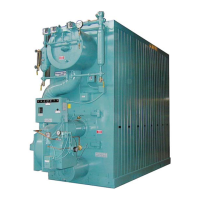
